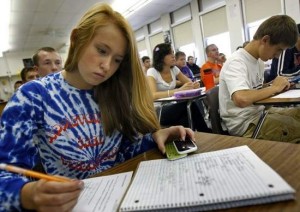 My local newspaper recently interviewed me about cheating and cell phone use in the classroom (read the article). While cheating and scientific integrity are important topics to talk about later, I have been thinking a lot about my new cell phone policy this year.
My local newspaper recently interviewed me about cheating and cell phone use in the classroom (read the article). While cheating and scientific integrity are important topics to talk about later, I have been thinking a lot about my new cell phone policy this year.
Overall, I am confident that allowing cell phones in the classroom was the right decision. I encourage students to use their phones appropriately in labs and lessons, and even prompt them to search for answers (they seem to like texting queries to ChaCha most) There is no more hiding (at least much less) their texting shame underneath their desks. While I have had to address using their devices at appropriate times, I haven’t had to confiscate a phone yet.
While the reporter got most of interview correct from what I said, the best quote came from my assistant principal:
We know they’ve got them, so it’s just teaching them to be responsible with them.
And that’s the idea. I trust that my students realize the power of their devices, and that they can make decisions to use them in an appropriate manner.
Most importantly, I think that students feel more respected.

Recent Comments